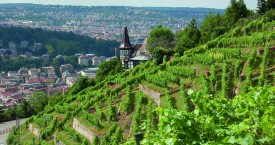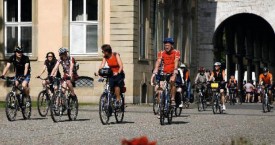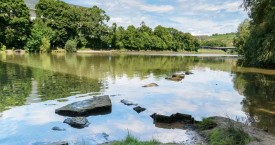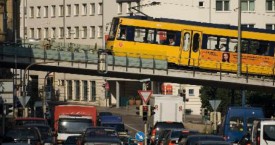Das Pariser Klimaabkommen vom Dezember 2015 sieht die Begrenzung der globalen Erwärmung auf maximal 2 °C, die Förderung der Klimaresistenz durch Anpassungsmaßnahmen sowie die Finanzierung des Klimaschutzes und der Klimaanpassungen vor. Jedes Land hat sich verpflichtet die Ziele dieses Abkommens durch konkrete Maßnahmen zu erreichen.
Ohne die Mitgestaltung der Städte, ohne aktives Mitwirken der Zivilgesellschaft und der Bürgerinnen und Bürger werden wir diese Ziele nicht erreichen. Deshalb ist jede Kommune gefordert, ein langfristig angelegtes Klimaschutzkonzept zu erarbeiten und systematisch umzusetzen
Stuttgart hat eine große und lange Tradition, unsere natürlichen Lebensgrundlagen zu schützen. Es begann vor allem im 19. Jahrhundert, als die Stadt durch die Industrialisierung schnell wuchs und der Talkessel immer mehr zu einem Smogkessel wurde.
Klimatzschutz-Konzept Stuttgart, KLIKS
1997 verabschiedete der Gemeinderat das Klimaschutzkonzept. „KLIKS“ wurde seither konsequent weiterentwickelt, damit Stuttgart die „Großstadt zwischen Wald und Reben“ bleibt. So wurden inzwischen über 39% der Gemarkung unter Natur- und Landschaftsschutz gestellt; ein deutscher Rekord. Zahlreiche Innovationen rufen Umwelttechnologien hervor, die sowohl neue Chancen für qualitatives Wachstum, nicht nur in Stuttgart, als auch neue Arbeitsplätze geschaffen haben und schaffen. Auch in Zukunft wollen wir alle Möglichkeiten ausschöpfen, um eine beständige, positive Veränderung des Stadtklimas zu erreichen: Wir bauen die Nutzung erneuerbarer Energien aus, um eine dauerhafte, kostengünstige und umweltfreundliche Energieversorgung zu sichern. Wir senken den CO2-Ausstoß weiter, kümmern uns um den Gewässer- und Bodenschutz, den Ausbau von Grünflächen und die Renaturierung von Brachflächen, um für uns wie für die Tierwelt einen Erholungs- und Lebensraum in unserer Stadt zu erhalten. Wir reduzieren die Lärmbelastung, verringern den Feinstaub und bauen die Radwege aus, um unsere Gesundheit zu schützen. Wir fördern energiesparende Häuser, unterstützen die Bereitschaft von Kindern und Jugendlichen zum Einsatz für die Umwelt, vergeben Baumpatenschaften und freuen uns über das persönliche Engagement aller Stuttgarter Bürgerinnen und Bürger. Wir nutzen den stadteigenen Abfallwirtschaftsbetrieb auch zur Wiederverwertung von Rohstoffen und gewinnen Energie aus dem Abwasser. Wir arbeiten in der Metropolregion Stuttgart zusammen, unterstützen nationale und internationale Projekte und teilen unsere gewonnenen Erfahrungen mit anderen Städten und Kommunen.
Unser Arbeitsplan mit detaillierten Maßnahmen umfasst 10 Aufgabenfelder.
– 10 Aufgabenfelder –
1. Nachhaltige Stadtentwicklung
Leitbild: urban – kompakt – grün
- Grünbestände sichern
- Stuttgarts Freund: der Baum
- Aktionsplan gegen Lärm
2. Energiesparen und Energieeffizienz
- Energiemanagement kommunaler Gebäude
- Energiecontrolling und Energetische Leitlinien
- Stadtinternes „Contracting“ für Energiesparprojekte
- Energie effizienter erzeugen und erneuerbare Energien einsetzen
Solarenergie - Das städtische Energiesparprogramm und energetische Vorgaben für private Investoren
3. Umweltfreundliche Verkehrsentwicklung
- Ausbau des öffentlichen Nahverkehrs
- Verbesserter Verkehrsfluss in der City
- Radfahren in Stuttgart
4. Bodenschutz
- Stuttgarter Bodenatlas
- Landwirtschaft, Streuobstwiesen und Gartenpflege
5. Gewässerschutz
- Bäche, Flüsse und Seen
- Staatlich anerkannte Heilquellen
- Trink- und Grundwasser
6. Abwasserbehandlung
- Klärwerke
- Wärme aus Abwasser
7. Abfallwirtschaft
- Müllverwertung in S-Münster
- Abfallwirtschaft Stuttgart (AWS)
8. Öffentlichkeitsarbeit und Bürgerengagement
- Information und Beratung
- Bürgerschaft und Unternehmen gewinnen
- „Stuttgart atmet auf“
- Energiesparlampen
- Eco-Fit-Programm
- Umweltpreis
- „Natürlich Stuttgart“
- „Let’s Putz“
- Die Bürger helfen mit
9. Forschungsprojekte
- Forschungsvorhaben der Stadt
- „Triple Zero“ in der Metropolregion Stuttgart
10. Netzwerke für den Erfahrungsaustausch
Fazit:
Neun von zehn Stuttgartern sagen, sie leben gerne in unserer Stadt. Ziel unserer Arbeit ist es, dass sie sich auch in Zukunft hier wohl fühlen werden.
The Paris Climate Treaty from December 2015 foresees limiting global warming to 2 °C, fostering climate resistance through adaptation measures, financing climate protection and climate adaptation. Each country has committed itself to achieving the goals of this agreement through specific measures.
These goals cannot be achieved without the contribution of cities, the active participation of the civil society and the citizens. Therefore, every municipality is required to develop a sustainable climate protection concept and to implement it systematically.
The City of Stuttgart looks back on a long and great tradition of safeguarding our habitat and natural resources. First concerns were raised in the 19th Century as Stuttgart underwent rapid growth in the wake of the industrial revolution, turning the city basin into a cauldron swathed in smog and fumes.
Climate-protection concept, Stuttgart, KLIKS
In 1997, the City Council passed the climate protection scheme. “KLIKS” has since been consistently extended to keep Stuttgart true to its well-known adage as the “city nestled between forest and vineyards”. Over 39 per cent of Stuttgart’s surface area has since been placed under the protection of nature conservation orders; a record in the whole of Germany. Wide ranging innovations have given rise to environmental technologies which not only offer new opportunities for qualitative growth in Stuttgart and beyond, but have also created and are creating new jobs. Our aim for the future is to continue to exhaust every possible avenue to achieve sustainable improvement of the city’s climate. We are extending the use of renewable energy sources in order to secure a continuous, favourably priced and environmentally friendly energy supply. We are continuing to reduce CO2 emissions, and making a concerted effort to ensure effective soil and water conservation, to expand our green spaces and denaturize brownfield sites and so preserve recreational areas and a healthy natural habitat for ourselves and for wildlife. We are cutting down on noise pollution, reducing particulate and extending the cycle path network, with all the associated health benefits. We provide grants for energy saving homes, support initiatives by children and young people to make a difference to the environment, run a tree adoption scheme and are appreciative of the personal commitment shown by all Stuttgart’s citizens. We use the city’s own
waste management company to recycle raw materials and we extract energy from sewage water. We join forces in the metropolitan region of Stuttgart, we support both national and international projects and share the experience we have gained with other cities and communities.
Our working plan with detailed measures comprises 10 fields of action.
– 10 Fields of Action –
1. Sustainable urban development
Our mission: Urban – compact – green
- Protecting the green belt
- Stuttgart’s friend: the tree
- Action plan to counter noise pollution
2. Energy saving and energy efficiency
- Energy management of public buildings
- Energy controlling and energy guidelines
- Internal contracting of energy saving projects
- More efficient generation of energy and use of renewables
Solar energy - The Municipal Energy Saving Program and energy regulations for private investors
3. Environmentally friendly traffic development
- Expansion of public transport network
- Improving the traffic flow in the city
- Cycling in Stuttgart
4. Soil conservation
- Stuttgart soil atlas
- Agriculture, open orchard meadows and horticulture
5. Water protection
- Streams, rivers and lakes
- State approved healing springs
- Drinking and ground water
6. Waste water treatment
- Sewage plants
- Heat from sewage water
7. Waste management
- Refuse incineration in Münster
- Stuttgart’s Municipal Solid Waste Management Enterprise (AWS)
8. Public relations and civic commitment
- Information and advice
- Motivating residents and businesses
- “Stuttgart takes a deep breath”
- Energy saving bulbs
- Eco-Fit Program
- Environmental award
- “Naturally Stuttgart”
- “Let’s clean up Stuttgart”
- Residents lend a helping hand
9. Research projects
- Municipal research projects
- “Triple Zero” in the metropolitan region of Stuttgart
10. Networks for exchange of experience and good practice
– Result –
Nine out of ten residents of Stuttgart affirm that they like living here. Our work is aimed at ensuring that they continue to feel at ease in our city in the years to come.






